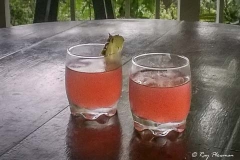Flora and Fauna at Asa Wright Nature Centre
The Asa Wright Nature Centre and Lodge is a non-profit making nature reserve. Formerly cocoa, coffee, and citrus plantations were called the Spring Hill Estate. Now the secondary forest has partially reclaimed the old estate plantations. It is a rewarding place to visit, whether as a day visitor or staying full board in the Lodge. And excellent security makes for an enjoyable stay, especially for independent travellers. It is in the stunning Arima and Aripo valleys part of Trinidad’s northern mountain range.
Asa Wright Nature Centre and Lodge
[foogallery id=”16248″]
Main House and Veranda

Asa Wright’s famous veranda has several bird feeders allowing close views of the birds. In addition, every morning, the staff pace fresh fruit below the veranda to attract birds and other wildlife. Further, the view across the Arima Valley towards the crested oropendola bird colony is spectacular. Moreover, accommodation is on a full board basis; three meals plus afternoon tea and rum punch on the veranda before dinner.
Trails and Wild Animals
After breakfast on the first morning and for day visitors, you get an informative orientation tour that follows the discovery trail. Further, the tour includes both the golden-headed and white-bearded manakin leks and ends in the territory of the bearded bellbird. Finally, you get a guided tour to Dunston Cave, home to the oilbird colony, if you stay for several days.
Residents have access to around five easy-going trails, which take about an hour or so to complete. Another two are more challenging and can take two to three hours each. As well as eye-catching birds, there are opportunities to see and photograph other plants and animals. Also, the driveway is rewarding for birdwatching and photography. And if you are lucky, the on-duty senior naturalist guide may organize a driveway night walk. The night I went, I saw two impressive tarantulas.
Fauna at Asa Wright Nature Centre
[foogallery id=”16253″]
Native Fauna at Asa Wright
Red-rumped Agouti is a Neotropic rodent that inhabits forest and degraded forest. Their diet includes seeds, fruits, roots, and leaves.
Gold Tegu (tiger lizard). They are one of the largest omnivore lizards in the Neotropics. And their diet includes fruits, invertebrates, small animals, lizards, and carrion.
Greater Windward Skink, a recently discovered semi-arboreal species found on trees and the ground. Moreover, their habitat includes rainforest, cultivated and disturbed areas.
Chevron Tarantula is a juvenile in a handrail on the main drive. Adults are nocturnal and arboreal inhabiting rain forests preferring to hide behind tree bark and in rot holes. Adults grow between 11 cm and 14 cm.
Manicou Crab, a freshwater land crab, found near mountain streams; I photographed this subject at Dunston Cave. One of a few species that do lay their eggs in the sea. Instead, a pouch on the female’s abdomen holds the eggs which hatch and develop.
Julia Butterfly is part of the Nymphalidae (Brush-footed butterflies) family. Found in clearings, paths and edges of the forests feeding on nectar.
Leaf-cutter Ants carry leaf segments back to their nest, mulching the leaves and growing fungi for food. The queen and other ants in the colony eat the fungus. Further, the ants rely on bacteria, which lives on their skin, to combat fungi pests. This symbiotic relationship benefits both partners.
Moreover, the two photographs show worker ants carrying leaf segments back to the nest. On one leaf is a small ant which the larger worker ant is carrying. This ant is not taking a free ride but is a guard-ant, which this there to stop parasitic fly attacks on the worker ants. Parasitic flies lay eggs on worker ants heads. Then the egg hatches into larvae, burrowing into the worker ants head, killing, and then eating it.
Flora at Asa Wright
Tropical plant identification can be difficult as they are not well documented. For example, Trinidad and Tobago have over 2,500 species, with 2,000 are flowering plants, but only 110 are endemic (Ref 1). Of the flowering plants I photographed at Asa Wright, only eight species are native.
Native Plants at Asa Wright
[foogallery id=”16264″]
Native Plants at Asa Wright
Featured images show native plants photographed in the Nature Centre Garden and along some of the forest trails. The gallery features four herbaceous Heliconias that include: (1) bastard plantain, (2) pendant heliconia, (3) heliconia chartacea and (4) heliconia mathiasiae. Moreover, the Heliconias primary pollinators are hummingbirds that feed on their nectar. The final four images are herbaceous plants: (1) changeable velvetberry, (2) vervain, (3) kohleria Regel and (4) hot lips shrub. Both the vervain and changeable velvetberry attract ruby-topaz and tufted coquette hummingbirds.
Introduced Plants at Asa Wright
[foogallery id=”16254″]
Introduced Plants at Asa Wright
The gallery features a few introduced or naturalised plants and some ornamentals; none appears on Trinidad and Tobago Invasive Alien Species list (Ref 1). The robusta coffee is an introduced tree/shrub in the original plantation; it is of North Africa origin. And the images are young plants, so probably self-seeded.
Also included are two ornamental trees and shrubs that attract nectar feeders, such as hummingbirds and bananaquits, are the mimosa tree and the sanchezia (Sanchezia parvibracteata) shrub. Although Sanchezia parvibracteata is native to Northeast Venezuela, it is not to Trinidad native shrub. Another couple of ornaments in the garden were the red ginger and Cardinal’s guard. Herbaceous flowering plants include torch ginger along some forest trails, so probably an escapee from the garden. And latter seems to have spread along the trails near the house.
Asa Wright Nature Centre References: Online Resources
1. Government of Trinidad and Tobago (2020). T&T Biodiversity. [Online] Available from: http://www.biodiversity.gov.tt/index.php/trinidad-a-tobago-biodiversity.html [Accessed 29th Apr 2021].